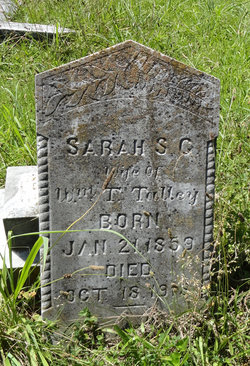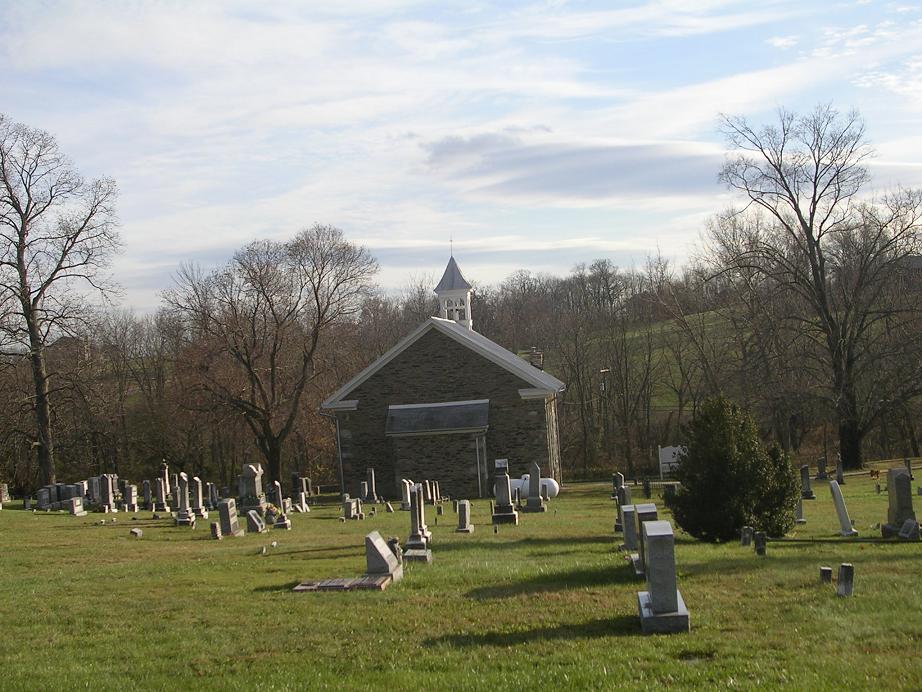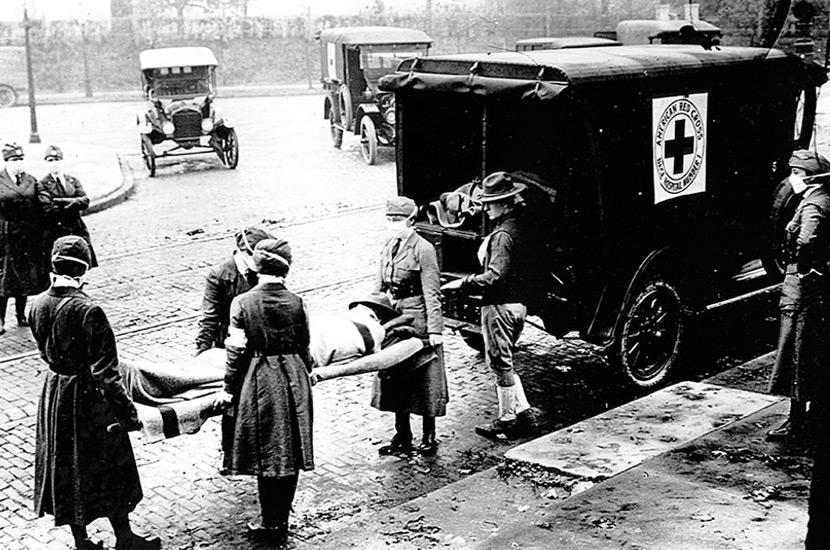The Spanish Flu pandemic of 1918-1919 was the worst ever in world history – except perhaps for the 14th century Black Death — taking an estimated 675,000 lives in the United States, and 50 to 100 million worldwide. No one really knows for sure.
From the global scale, down to the local level such as Lovettsville, it is impossible today – or even back then – to know how many deaths were caused by the Spanish Flu. Our research has documented at least 12 deaths in the Lovettsville District mostly likely caused by that dread disease, out of 50 to 70 deaths during the year of 1918. These were all in October and November. There were likely more during 1919, which we have not yet documented.
Although you will often hear that what is happening today with the coronavirus and Covid-19 is “unprecedented,” it isn’t. The biggest difference between then and now is the rapidity of communications, and advances in medicine.
In Loudoun County, as well as across the country, churches and schools were closed during the Spanish Flu epidemic, as were other places of entertainment. Throughout the country, large public gatherings were banned. Facial masks were encouraged everywhere, and masks were legally required in a number of large cities. Violators were arrested and fined.
In this area, the churches appear to have been closed from mid-October 1918 through December, or even into 1919. In the minutes of the St. James Church Council, we find the following entry dated January 8, 1919: “On account of the Epidemic of the Spanish Influenza the churches thus (ordered?) closed until further notice.” The Loudoun Mirror reported on October 15 that the Hillsboro Circuit of the Methodist Episcopal Church, which included Mount Olivet in Lovettsville, was closed. The minutes of the New Jerusalem Lutheran Church Council, which normally met monthly, don’t show any activity for September, October, or November of 1918. There were no baptisms at New Jerusalem between August 14 and November 24, 1918, and then suddenly there were eight baptisms in December.
Then as now, public officials frequently issued optimistic statements proclaiming that the epidemic was abating, and that the Flu was going away. Such statements were common even during the peak of the epidemic, in October 1918, and can be found in local and regional newspapers.
And there were also various home remedies – quack remedies actually – which people used to try to prevent or treat the Spanish Flu. Among the more benign of these was liquor, generally not in short supply in the hills and hollers around Lovettsville.

But then consider the case of Sarah Talley of the Neersville/Between-the-Hills area. She was born a Waters, the name by which that community used to be known. Sometime on October 15 or 16, 1918, the 59-year old Widow Talley tried a remedy which she had no doubt heard recommended – Oil of Wintergreen – with unfortunate results. A physician, Dr. Nathaniel Burwell of Shepherdstown, was summoned early in the morning of October 16, but was unable to save Mrs. Talley; she died about an hour later. Her death certificate, made out by Dr. Burwell, stated as Cause of Death: over dose of Oil of Wintergreen; accident trying to prevent `flu.’ Oil of Wintergreen was in fact used in vapor form, along with camphor and menthol (the latter two being the primary ingredients in Vicks VapoRub, first marketed in 1905). She was buried at St. Paul’s Lutheran Church two days later.
Now, let’s look more closely at 1918 and 1919.
In the U.S., the Spanish Flu hit in three waves during 1918-1919, according to most experts, although some think there were actually four waves.
The first wave emerged in Kansas in the Spring of 1918, and spread to the East Coast along with troop movements which were part of the mobilization to train and send U.S. troops to Europe. The first wave was relatively mild, and outside of Kansas, there were relatively few deaths.
The second wave, far more deadly, emerged in September, hitting first among troops and then civilians in Boston, then spreading to the Philadelphia Navy Yard, and to Quantico Marine base and Camp Lee in Virginia, among other places. By early October, the flu was raging at Camp Meade in Maryland, and in the District of Columbia, where many prominent officials were sickened. The U.S. government ordered all federal employees to wear masks.
A third wave struck in the first part of 1919. “Influenza Again Hits Loudoun County,” reported the Loudoun Times on January 8. “With Renewed Force the County is Being Swept by This Epidemic Which is Exacting a Heavy Toll.”
Lovettsville and its neighborhood
Lovettsville, although rural, was located in a region of the country that had a Spanish Flu death rate well above the average for the United States. The state with the highest mortality rate for Spanish Flu in 1918 was Pennsylvania; our neighbor Maryland was second. Virginia was a bit down the list, at number 11. The number of deaths attributed to Spanish Flu in Virginia was estimated at 16,000. Cities, being more densely populated, had higher fatality rates than rural areas. Baltimore was 7th, and Washington D.C. was 12th, in the nationwide rankings of the influenza mortality rate in 1918.
In Loudoun County, about 90 deaths out of a total of 354 were officially attributed to “influenza” in 1918. This figure is undoubtedly low, since the “Spanish Flu” was not well understood at the time, nor was there any test for it. As we see today with Covid-19, there were many complications of the Spanish Flu – affecting lungs (pneumonia, tuberculosis), respiratory tract (bronchitis), kidneys (nephritis), the heart, or other organs — so that the cause of death (COD) might be listed as the resulting complication, not the Flu itself.
Loudoun County appears to have had a lower-than-average death rate. The influenza death rate per 1000 people was 17 for Loudoun. This compares to the rates for nearby jurisdictions: Alexandria City – 49; Alexandria County 16; Fairfax County — 42; Fauquier County – 14; Clarke County – 18; City of Winchester – 27, and surrounding Frederick County (Va.) – 12.
Among Loudoun County’s six magisterial districts, the Lovettsville District had the smallest number of deaths officially attributed to influenza, six, in the Fall of 1918. This is somewhat surprising because of its proximity to the B&O railroad yards in Brunswick, which was a Spanish Flu hotspot; about half of the Brunswick population was reported to be sick with the flu in October 1918. (The highest district in Loudoun County was Leesburg, with 24 deaths.)
However, by using cemetery records, newspaper accounts, and other sources, we have already determined that the real Lovettsville death toll was at least twice as high as reported.
Figuring out the whole picture
A number of obstacles get in the way of trying to put together a complete picture of what happened in 1918-19.
First, we have found that many deaths in the Lovettsville area were simply not officially recorded by Loudoun County, probably because they were just not reported. For 1918, it looks like only about 50 of some 70 deaths were reported to County officials. This shouldn’t be surprising to anyone familiar with the history of northern Loudoun County.
The Lovettsville area’s isolation from the rest of Loudoun County, is a historic feature which goes back to its character as “the German Settlement,” populated largely by the “Pennsylvania Dutch” who were looked down upon by Loudoun’s elite because of their language and cultural differences. Then, generations later, Lovettsville’s pro-Union majority during the Civil War resulted in its political isolation – if not ostracism – well into the 20th century. (The Lovettsville and Waters precincts were two of the three precincts in the County that voted against secession in 1861.) So it could be expected that more than a few deaths – and births, etc. – were not even reported to Leesburg and included in Loudoun County’s vital statistics. For example, “delayed birth certificates” were fairly common, as people often didn’t need them until they needed to get a Social Security card for employment purposes. A housewife might never need to get one.

The other side of this isolation from Loudoun County, was that many Lovettsvillians and north Loudoun residents had closer commercial, religious, and family ties to Frederick County, Maryland, and Jefferson County, West Virginia, than to the rest of Loudoun County. This included hospital usage. Many people from this area used the hospital in Frederick rather than the one in Leesburg, and people in the Between-the-Hills area and Neersville often used the hospital in Charles Town, and doctors in Harper’s Ferry. (As an example: the Loudoun Mirror reported on October 22, 1918, that Charles Heater had undergone an operation at the Frederick Hospital for complications arising from the Spanish Flu. He apparently survived and lived until 1952.)
For our purposes here, one consequence of this would be that if a Lovettsvillian died at the hospital in Frederick (or at the emergency hospital in Brunswick), his or her death would not be recorded in Loudoun County.
Church records
Here arises a second complication. Churches are often a good source for burial records, and information on causes of death. However, looking at the period of the Spanish Flu, we are faced with a couple of problems.
Two of the largest churches – St. James Reformed, and New Jerusalem Lutheran – were without pastors at the time, so few, if any, burials were recorded in the church registers. New Jerusalem was between Pastors Mauer and Poffenberger, and recorded no burials between October 1, 1918 and January 4, 1920. St. James was between Pastors Stonebraker and Harner during the peak of the Spanish Flu, and between October 1918 up to February 1920, it recorded only two burials. (These were Maggie Goodhart, widow of the undertaker Elijah Goodhart, a reported suicide in December 1918; and Dr. Harry Buhrman, who suddenly dropped dead in Eamick’s store in June 1919.
Where are the newspapers?
Lack of newspapers, and the paucity of coverage, present a big obstacle in this case. Normally, in this region and around the country, local newspaper accounts give us the best picture of the day-to-day, week-to-week development of the Spanish Flu epidemic in the United States and the world-wide pandemic. The Loudoun newspapers contain relatively little reporting on the impact of the Spanish Flu in the Lovettsville area – for reasons we’ve already discussed.
The best source of newspaper information would be the Brunswick Blade–Times – the predecessor of the Brunswick Citizen which is still today Lovettsville’s local newspaper. Unfortunately, the issues of the Blade-Times for the years before and after the Spanish Flu epidemic are missing, and have never been found.
What we do know…
Despite all these problems, it is still possible to supplement the official death records with information from other sources: cemetery records, family histories, and newspapers where they exist. So, using those sources that are available to us, we can put together somewhat of a picture.
First, we can document at least 12 deaths from Spanish Flu in the Lovettsville (Magisterial) District. (13 if you count the poor Widow Talley.) There were undoubtedly others beyond these, where the complication of the disease was cited as cause of death, rather than the disease itself. The known deaths are listed below.
Second, we can see how the Spanish Flu hit in clusters, and even families. We see two cases where the flu killed both a mother and daughter: Martha Cogle, 65, and her daughter Ida Axline, 38; and Sarah Virts Meyers, 31, and her infant daughter. The Myers family is an example of where deaths were not recorded by the County, but were passed down in the family, according to genealogist Gary Virts.
There are many cases where further research will likely show multiple family or other close connections among those sickened and killed by the Spanish Flu.

Third, looking at cemetery records, we see a clear pattern of Spanish Flu deaths clustering around the Short Hill. The cemeteries with the highest percentage of Spanish Flu burials in 1918 are as follows:
Mount Olivet Methodist (Mountain Road) – 4 of 7 burials
St. Paul’s Lutheran, Neersville – 3 of 9 burials
Ebenezer Methodist, Neersville – 2 of 7 burials.
The other local cemeteries are:
Lovettsville Union Cemetery – 2 of 25 burials
Mount Pleasant Methodist, Taylorstown – 1 of 11 burials
New Jerusalem Lutheran – 0 of 2
St. James Reformed – 0 of 3
Old Presbyterian – 0 of 1
African Methodist Episcopal (“African Chapel”) – 0 of 1
Rehobeth Methodist, south of Lovettsville; and Salem Methodist, Neersville – 0 of 0
Lovettsville District deaths attributable to Spanish Flu, October-November 1918
[“COD” = “Cause of Death”]
Oct. 6 – Lelila M McGaha, 24, daughter of John William and Nettie Brislin McGaha; COD influenza & pneumonia; buried Lovettsville Union Cemetery
Oct. 13 — Ida Cogle Axline, 38, died at her home near Elvan; COD bronchial pneumonia of four days duration; wife of John William Axline, married 1911; daughter of Samuel and Martha Cogle. “She was well known in upper Loudoun and will be missed by a large circle of friends and relatives,” said the Loudoun Mirror, 10/29/18; buried at Mount Olivet Methodist Cemetery.
Oct. 15 — Maggie Kelly, 6, COD “possible pneumonia;” said to be buried in Petersville MD, but grave not found.
Oct. 16 — Martha Cogle, 65, COD was influenza and complications per Loudoun Mirror; cancer of stomach per death certificate; wife of Samuel Cogle; mother of Ida Axline who died on Oct. 13. “The deceased was a good Christian lady, a good wife and mother, and will be greatly missed” per Loudoun Mirror 10/29/18); buried St. Paul’s Lutheran, Neersville
Oct. 16 — Sarah S.C. Waters Talley, 59, COD: “over dose of Oil of Wintergreen; accident trying to prevent `flu’” per death certificate; widow of William Turner Talley (1848-1913); her father was John F. Waters; buried at St. Paul’s, Neersville
Oct. 17 — Lourinda Ross Hackley Edwards, 51; COD “Double Lobar Pneumonia & Tuberculosis; daughter of William Hackley and Martha Herrell; married to Lewis R. Edwards, 1888; buried Ebenezer Methodist in Neersville.
Oct. 18 — Raymond D. Compher, 20, farmer, buried at Mt. Pleasant, Taylorstown.
Oct. 18 — Mamie Edwards, 44; COD Spanish Influenza; daughter of Abner and Mary/Mollie Conard Edwards; she had daughter Nellie Marie Edwards; buried St. Paul’s Neersville.
Oct. 23 — Charles A. Shumaker, 2; COD lobar pneumonia & influenza; son of William H. and Christina Speaks Shumaker; farm laborer; buried at Mount Olivet Methodist.
Oct. 23 – Sarah Catherine Virts Myers, 31. Per Gary Virts: “Married James Lee ‘Harry’ Myers, March 17, 1907 in Brunswick, Maryland. She and her daughter Ruth died in the Influenza Pandemic of 1918. They are buried together in an unmarked grave near the left side of the church, lot 21,” at Mount Olivet Methodist.
Oct. 23 – Ruth Myers (infant) (see above)
Oct. 29 — Annie Bell Demory, 3 mo.; daughter of Wm. W. Demory and Effie Payne; COD: “Spanish Flu. They could not get a doctor but knew it was that disease.” Buried Ebenezer Methodist, Neersville.
Nov. 11 — Lita Offutt Morrison, 30, COD Bronchial pneumonia; buried at Lovettsville Union Cemetery.
–Edward Spannaus
Sources: Lori Kimball provided official data on Loudoun County deaths in 1918. Thomas Balch Library provided access to local newspaper accounts from 1918-19. Gary Virts provided information on a number of individuals and families. Additional research on individuals and families was conducted on Ancestry.com, remote access provided by Frederick County Public Library. Church records courtesy St. James United Church of Christ, New Jerusalem Lutheran Church, and the Lovettsville Museum. Cemetery records from Find-a-Grave.com.
My recent study of the Spanish Flu in a Frederick County community can be found here.

